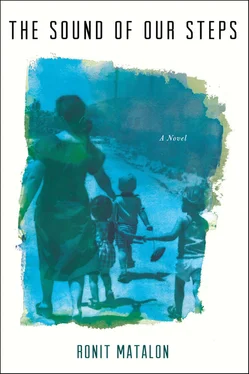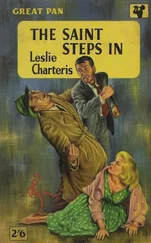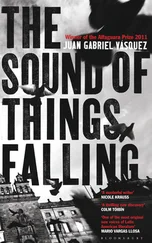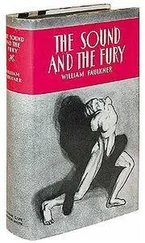Grandiflora: very similar to the floribunda and originating in the crossing of this species with the hybrid tea. They bear large flowers in small clusters.
Dwarf roses: they originate in the Chinese dwarf rose and other hybrids. They appear in all the other categories but their flowers are small and few.
Climbers: the classic climbers bloom once a year in large clusters consisting of small flowers. Their growth is vigorous and very strong. Flexible herbaceous growth. They are used to cover high fences, hedges, and out-of-the-way expanses.
SHE FIRST PLANTED the floribunda, combining the characteristics of the hybrid tea and the polyantha, behind the shack, in the long bed under the windows of the hall and the living room, which she changed around four times, and she changed the floribunda, too, after a few weeks, for classic climbers blooming in large clusters, which changed places and moved to the side of the shack, in the area between the shack and the brick wall of the welding shop, until they failed to flourish and she moved them back again to the back of the house, but this time to a new bed, to the right of the lawn next to the laundry lines, instead of the polyantha, which dried up completely and were thrown into the trash, or were burned together with the hybrid teas that were planted in front of the house, close to the path, in neat rows, where they bloomed once and never again, crushed by the heavy branches of the mango tree, which she sawed off to thin them out, and in their place she planted grandiflora bushes, some of which were left where they were and some uprooted and moved five yards away to the narrow strip of ground between the paving stones of the porch and the lawn, and they, too, failed to flourish, and for a while she tried to revive them in the big clay pots she bought from Marko, until she gave up and exchanged them for dwarf roses of the rambling variety, or the grandiflora polyantha hybrid tea, the Chinese or European species.
She wiped her hands covered with loose soil on the hem of her dress, sadly pursing her lips: “I don’t understand why I never succeed with these roses.”
“ELGNENA” AS A tireless arena of experiment, substitution, and change.
Elgnena as a battlefield.
Elgnena as unsuspended desire, eluding her the harder she tried to take hold of it.
Elgnena in place of suspended desire, her suspended desires.
Elgnena as the place where she tried to tame herself, in vain.
Elgnena as the place where she hardly learned anything, where she refused to learn.
Elgnena as an ancient, childish vision of purity, order, and beauty.
Elgnena as the defeat of order, purity, and beauty.
Elgnena as a playground, a sandbox, plastic blocks.
Elgnena as a constant yearning for the real, not as-if home, that she wanted to make for herself.
Elgnena as an invitation to climb a slippery mountain slope, to reach the peak, the rose garden.
Elgnena as a penal colony, a forced labor camp — for her, for her fellows.
Elgnena as a sanatorium.
Elgnena as a natural extension of the interior of the house, with the furniture and everything.
Elgnena is hers, only hers, hers.
Elgnena as an extorter of money, thousands and thousands of liras and shekels buried in its ground.
Elgnena as the main source of income for the owner of the plant nursery, Marko, who built a whole house from her horticultural ignorance.
Elgnena as a protest.
Elgnena as a protest against knowledge in favor of capricious, ignorant love, the opposite of knowledge.
Elgnena as a protest against the non-gardening neighbors.
Elgnena as a protest against herself.
Elgnena as a manifesto of love for the nature she never knew, never saw.
Elgnena as the aspiration for a life with a sky.
Elgnena as a pledge to something.
Elgnena instead of the yearning of the body, her body.
Elgnena instead of the body of a loving woman, her body in her imagination with the shutters closed.
SHE GAVE THE child to Nona, twenty days after she was born. This was the agreement between them and also a necessity: that she would give the baby to Nona and go back to work “after twenty days.” She always spoke about babies in days: twenty, forty. She would say, “When a baby has forty days, it means he’ll live. You have to wait for forty days.”
The twenty days, however, turned into a scale with a number of weights on it: that she had given the child to Nona, that she had gone to work right after, that she was “like a lion” after the birth, after giving up the child (“I was like a lion”), that she had been arrested for forty-eight hours, together with the child (“the child had twenty days”) because of Maurice’s debts, promissory notes he had made her sign before disappearing. They had let her go on the guarantee of Rabbi Nathaniel (“he was a good man, Allah yarhamo ”) in whose Savyon home she worked. He brought a fine gift for the child, a gift over the precise nature of which she and Nona argued for years.
The mother said, “A gold bracelet with her initials on it.” And Nona said, “A blanket. He brought her a Bourbon-rose-colored blanket. It was my brother Clement who sent the bracelet. Don’t you remember, Lucette?”
She didn’t remember, not exactly: going to bed with memory, delighting in its curves, were liberties available only to those who kept still, stayed in one place, like the Nona. So at least she told herself: she had no time to remember. She counted pain, too, even at the moment it happened, as a memory, a kind of illusion. She didn’t believe in it.
Nona said that the child was sick. She got fatter and fatter with the quantities of semolina the Nona fed her, and Nona said that she didn’t look right. There was something wrong with the child. Every day she pushed her in the carriage sent by Maurice’s brother from Italy (was he the one who sent it?) to the clinic, for some kind of penicillin. If they didn’t give her penicillin, or at least antibiotic pills, the Nona didn’t sleep at night: “I didn’t shut an eye,” she said. They walked to the clinic along the long, roundabout asphalt road, not through the fields, lingering five or six times on the way. Nona liked to linger. Her eyes never tired of gazing at the perfectly matching clothes, for which she was responsible, from the color of the baby’s hat, the trim of her socks, to the collar of her dress: then she still had her eyes. “Is there some celebration today that you dressed her up like that? What are you celebrating, Madame Esther?” people asked her in the street. They didn’t ask, they stopped her: “People stopped me in the street to ask, ‘Where’s the party, Madame Esther?’” said Nona.
“Stop it,” the mother scolded her, “stop dressing her up every day. Who do you think she is?” But Nona didn’t listen and she didn’t stop. She sank up to her neck in her double- and triple-entry bookkeeping of the Evil Eye and her measures to counteract the Evil Eye, until she became so confused by the figures and calculations that she drowned in them.
“The child is sick” was an antidote to the Evil Eye of remarks like “Where’s the party, Madame Esther?” but not effective enough against the frontal attack of “What a little doll!” against which only antibiotics would serve, but even they were useless against the worst of all: “What a healthy child.” Here only shots of penicillin would do. So far everything was simple. But the accounting became more complicated and labyrinthine, with no way out, when the doctor herself, under the Nona’s urging to prescribe something, said: “What a healthy child.” Nona was speechless. She “saw everything black”: the impenetrable barrier separating the world of the demons from that of the angels came tumbling down, and from then on every angel was a demon in disguise and every demon sported the halo of an angel.
Читать дальше












